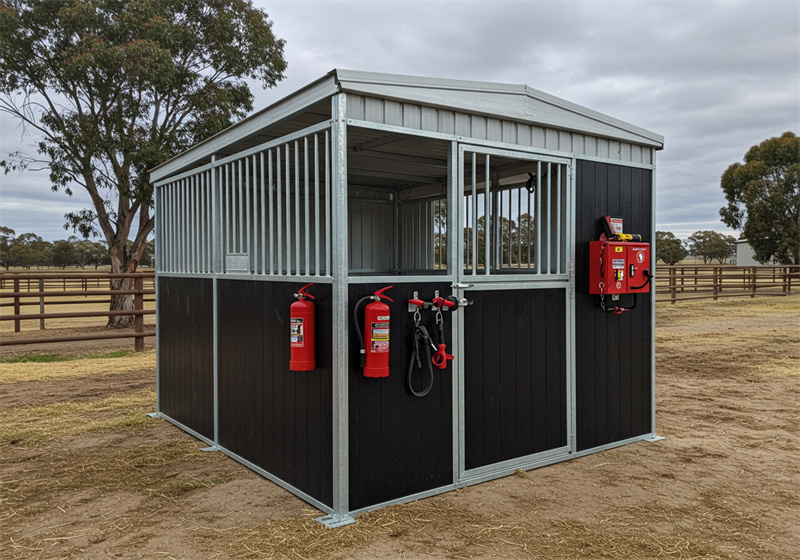Building a commercial horse barn isn’t just about providing shelter—it’s about creating an operational asset that drives your business forward for decades. This comprehensive guide cuts through generic advice to address the real challenges facing large-scale Australian equestrian operations, from navigating extreme climate variations to ensuring maximum return on investment. We’ll walk you through everything from strategic planning and prefabricated systems to material selection and long-term value analysis, giving you the blueprint to build a facility engineered for peak performance.
- A new barn is an operational asset, not just shelter. Strategic planning for workflow and scalability is essential before construction begins.
- Prefabricated systems offer significant advantages in speed, cost certainty, and quality consistency for large-scale operations.
- Australia’s diverse climates demand region-specific design. A barn in Queensland has different engineering needs than one in Tasmania, especially regarding ventilation, insulation, and cyclone ratings.
- Understanding material specifics, like the difference between hot-dip galvanized and pre-galvanized steel, is crucial for ensuring a 25+ year lifespan and long-term return on investment.
A new barn complex serves as the operational heart of your business. It represents a massive capital outlay and a decision that impacts your efficiency, animal welfare, and profitability for decades. While many guides discuss generic stables, they often fail to address the specific complexities faced by large-scale Australian operations—from navigating diverse climates to ensuring long-term value. This blueprint takes a different approach. We’ll guide you on a strategic journey, moving from high-level planning to material selection and investment analysis. Consider this your roadmap to de-risking your investment and building a facility engineered for peak performance.
The Foundation: Why Prefabricated Systems are the Future for Commercial Equine Facilities
Prefab systems aren’t just faster—they deliver superior quality control, cost certainty, and durability that traditional on-site construction simply can’t match at commercial scale.
When you hear “prefabricated,” you might picture a simple, temporary structure. The reality for commercial equine facilities involves highly engineered systems designed for performance and longevity. The core advantages lie in moving the complex construction process from an unpredictable field environment into a controlled factory setting.
Speed and Certainty: The Advantage of Off-Site Construction
Traditional on-site construction can drag on for months, subject to weather delays, contractor schedules, and unforeseen site issues. A prefabricated system compresses this timeline into weeks. While your site undergoes preparation, the entire structure gets built in parallel at a factory. This minimizes disruption to your daily operations and provides a clear, reliable project schedule. You gain cost certainty and get your facility operational much faster.
Engineered for Excellence: Quality Control and Consistency at Scale
Precision matters when you’re building a facility for 20, 50, or 100+ horses. In a factory, steel components get cut and welded by specialized machinery and experienced fabricators, ensuring every joint is perfect and every panel is identical. This level of quality control proves nearly impossible to replicate in the field. The result delivers a structure with superior strength and consistency across the entire complex, from the first stall to the last.
The Myth of Temporary: The Durability and Longevity of Modern Prefab Systems
A common misconception suggests that “prefabricated” means flimsy or short-lived. Commercial-grade systems feature engineering from heavy-duty structural steel, often hot-dip galvanized for maximum corrosion resistance. These aren’t temporary sheds; they’re permanent assets designed for a structural lifespan of 25 to 50 years, built to withstand the rigors of a working equestrian business and Australia’s tough conditions.
Strategic Planning: Blueprinting Your Barn for Peak Operational Efficiency
The most expensive mistake you can make is building a beautiful barn that functions poorly—smart design maps out horse, people, and material flow before the first piece of steel gets ordered.
Excellent design goes beyond aesthetics and stall counts; it plans for the movement of horses, people, and materials. This foundation creates a barn that saves you time and money every single day.
How will you define success? Setting Clear Operational Goals
Begin by defining your primary objectives. Are you trying to increase training capacity, reduce daily labor costs, improve biosecurity, or prepare for future business growth? Answering these questions first connects your goals to specific design choices. A goal of reducing labor, for instance, directly influences the layouts for feed delivery and waste removal to make them as efficient as possible.
Designing the Workflow: Beyond the Stall
A barn thrives as a dynamic environment. Consider the daily flow of traffic. Plan for efficient feed delivery routes, straightforward waste removal, and dedicated access for vets and farriers. Map out how horses move safely between stalls, wash bays, tack-up areas, and arenas. Integrating tack rooms, feed storage, and staff facilities into this workflow prevents bottlenecks and creates a safer, more productive environment.
Planning for Growth: How to Build a Scalable Barn System
Your business may grow, and your facility should grow with it. A well-designed master plan for your site proves invaluable. Modular prefabricated systems excel at this. You can construct your facility in phases, starting with a core block of stables and support rooms. Later, you can easily add new stable blocks or facilities that integrate perfectly with the existing structure, all without major disruption.
Durable Portable Horse Stables Built for Safety and Convenience
Explore DB Stable’s customizable, heavy-duty portable stables crafted with HDPE infill and galvanized steel. Designed for quick assembly and long-lasting performance, our stables provide secure, flexible solutions tailored to your equestrian needs.

Engineered for Australia: Designing for Climate, Challenge, and Compliance
Australia isn’t one climate zone—a facility in Far North Queensland needs completely different engineering than one in Tasmania, from cyclone ratings to insulation requirements.
Australia spans multiple climate zones. A facility in Far North Queensland has vastly different needs from one in Tasmania or the arid interior. Applying a one-size-fits-all approach creates a recipe for long-term problems with animal health, structural integrity, and operational costs. A truly great barn gets designed for its specific location.
What does climate-appropriate design truly mean?
Designing for your local climate leverages natural conditions to your advantage. It’s about more than just providing a roof.
- Northern Australia (QLD, NT): Here, the focus centers on managing heat and humidity. Key features include maximizing passive ventilation with features like ridge vents and gapped eaves, ensuring high cyclone ratings for wind loading, and using materials with superior corrosion and UV resistance, such as hot-dip galvanized steel and high-grade cladding.
- Southern Australia (VIC, TAS, southern SA/WA): In these regions, thermal stability takes priority. The design must manage condensation, provide excellent insulation to protect against cold, maximize natural light during winter months, and offer robust protection from prevailing storms.
- Arid & Central Australia: Barns in these areas must manage extreme temperature shifts from day to night. Key considerations include dust suppression features, highly reflective roofing to reduce heat gain, and water-wise design for conservation.
| Climate Zone | Key Challenge | Recommended Ventilation | Ideal Insulation | Recommended Cladding |
|---|---|---|---|---|
| Northern | Heat, Humidity, Cyclones | Maximum passive airflow; ridge vents | Roof insulation (e.g., blanket or sandwich panel) | High-grade steel with superior coating |
| Southern | Cold, Condensation, Storms | Controlled; adjustable louvres | Roof and wall insulation; anti-condensation blanket | Insulated paneling or standard steel with insulation |
| Arid/Central | Extreme Temp Swings, Dust | Good airflow with dust screening | High-performance roof insulation | Light-colored, reflective steel (e.g., Colorbond) |
Are you prepared for Australian hazards? Bushfire and Biosecurity
Beyond climate, your facility must remain resilient to specific local threats. For many rural properties, bushfire poses a primary concern. Specifying non-combustible materials like steel framing and cladding provides a critical first step. Understanding your property’s Bushfire Attack Level (BAL) rating guides decisions on features like ember guards and appropriate window selections. This detail can save lives.
Biosecurity can also integrate into the design. A smart layout creates isolation zones for new or sick horses. Material choices like non-porous surfaces for walls and sealed concrete floors, paired with effective drainage, make cleaning easier and help you manage disease control protocols effectively.
Navigating the Red Tape: Council Approvals for Large Barns
Any significant structure requires council approval. For large rural barns, this process typically involves submitting certified engineering plans, a site plan, and other documents to obtain a building permit. The process can seem daunting, which makes it vital to partner with a supplier who provides the fully certified engineering documentation required for your application. This demonstrates their confidence in their product and simplifies your compliance journey.
The Anatomy of a Modern Prefab Barn: A Deep Dive into Materials and Components
A cheap price often hides compromises in materials that cost you more later—understanding steel grades, finishes, and component quality separates smart buyers from those who regret their choices.
The long-term performance of your barn comes down to the quality of its individual parts. Knowing what to look for transforms you from a passive buyer into an informed investor.
The Steel Skeleton: Understanding Framing and Finishes
The frame serves as the backbone of your structure. Pay close attention to the steel finish; hot-dip galvanized steel proves vastly superior to pre-galvanized. Hot-dipping coats the entire component in zinc *after* it has been cut and welded, sealing every edge and joint against rust. Also, ask about steel specifications. Heavier gauge tube (e.g., 2.0mm vs. 1.6mm) provides greater strength and impact resistance, which proves essential for a building that houses large animals.
The Skin of the Structure: Cladding, Roofing, and Insulation Options
The “skin” protects your barn from the elements. Colorbond steel remains a popular choice for cladding and roofing in Australia for its durability and wide range of colors. The roof pitch also proves important, as a steeper pitch sheds water more effectively and can improve airflow. Consider incorporating skylights to increase natural light and reduce electricity costs. For superior temperature control, insulated sandwich panels offer an all-in-one solution for roofing and insulation.
Inside the Barn: Stalls, Doors, and Integrated Systems
Inside the barn, safety and durability stand paramount. For stall partitions, look for thick, high-quality ply kickboards and heavy-duty steel mesh for ventilation. Doors should feature robust, horse-safe latches and heavy-duty hinges that can withstand constant use. A well-planned system also includes pre-designed conduits for electrical wiring and plumbing, making the installation of lights and automatic waterers simple and clean.
Decoding the Investment: A Guide to Transparent Pricing and ROI
The true value of a quality barn system gets measured over decades, not just on the initial invoice—operational savings from efficiency and durability prove the real return on investment.
A quality barn system represents a significant financial commitment, but its true value gets measured over decades, not just on the initial invoice. An honest supplier makes it easy to understand what you’re paying for, while a focus on long-term benefits reveals the true return on investment.
What’s in a quote? How to dissect costs and avoid hidden extras
A transparent quote should provide a complete bill of materials. It must clearly list what’s included, so you can make an apples-to-apples comparison between suppliers. Be wary of quotes that lack detail or have a long list of exclusions. A low initial price might not include critical items like fasteners, kickboards, or the engineering plans needed for council approval.
| Component | Supplier A Quote | Supplier B Quote | Supplier C Quote |
|---|---|---|---|
| Structural Frame (Steel Specs?) | |||
| Roofing & Cladding Material | |||
| Stall Dividers & Kickboards | |||
| Gates, Latches & Hinges | |||
| All Screws & Fasteners | |||
| Certified Engineering Docs | |||
| Delivery to Site |
Australian-Made vs. Imported Systems: A Strategic Comparison
The choice between locally manufactured and imported systems has direct consequences. Imported products can sometimes offer a lower initial price, but this may come with risks like lower-grade materials that don’t meet Australian standards, long and unpredictable lead times, and difficulty getting support or replacement parts down the track. Opting for Australian-made horse stables means you get verified material quality, local support from people who understand the conditions, and a much smoother path to council compliance.
Calculating the True Value: Long-Term ROI of a Quality Barn System
The final calculation should look beyond the purchase price. A well-engineered barn built from superior materials will have significantly lower maintenance costs over its lifespan. An efficient workflow design saves you hundreds of hours in labor costs each year. Better ventilation and conditions lead to healthier horses and fewer vet bills. These operational savings represent the true return on your investment, proving that choosing quality from the start makes the most financially sound decision.
Durable Portable Horse Stables Built for Safety and Convenience
Explore DB Stable’s customizable, heavy-duty portable stables crafted with HDPE infill and galvanized steel. Designed for quick assembly and long-lasting performance, our stables provide secure, flexible solutions tailored to your equestrian needs.

Choosing a prefabricated barn system represents a foundational business decision. It’s not about buying a product; it’s about investing in a strategic asset. By focusing on operational workflow, climate-appropriate design, and long-term value, you build a facility that meets your needs today and supports your growth for years to come. A well-designed barn becomes a silent partner in your success. The blueprint now sits in your hands—build with confidence.
Ready to translate this blueprint into a reality for your operation? Contact our specialists for an obligation-free consultation to discuss your specific needs and receive a detailed proposal based on these strategic principles.
Frequently Asked Questions
Q1: What are prefabricated horse barn systems?
A1: Prefabricated horse barn systems are complete equestrian structures where the main components like frames, trusses, and panels get made in a factory. They are then delivered to your property for quick assembly. This differs from smaller, portable stalls as these are permanent, engineered buildings.
Q2: How long does installation take for a large-scale barn?
A2: A large, multi-stall barn complex can typically get assembled on a prepared site within one to three weeks. This represents a small fraction of the time required for a traditional build from the ground up.
Q3: What are the typical council approval requirements in Australia?
A3: Most large barns get classified as Class 10a structures and will need a building permit from your local council. You must submit certified engineering plans and a site plan. Reputable Australian suppliers will provide the necessary engineering documentation for their system to support your application.
Q4: Can these systems be built on sloping or uneven ground?
A4: Yes, but site preparation holds the key. The ground usually needs leveling to create a flat pad. For minor, consistent slopes, the design can sometimes incorporate stepped foundations or custom post lengths, which requires specific engineering work.
Q5: What is the typical lifespan and warranty on a commercial-grade prefab barn?
A5: A high-quality, hot-dip galvanized steel system has an expected structural lifespan of 25 to 50 years. Warranties will vary, but you should look for a structural warranty of at least 10-15 years. Components like Colorbond steel often have their own separate manufacturer warranties.
Q6: Can I customise the layout and features?
A6: Yes. Modularity stands as a major benefit of system-based design. You can work with the supplier to customize the number and size of stalls, the placement of tack and feed rooms, the inclusion of wash bays, and the specific types of doors, windows, and ventilation.
Q7: What is the difference between hot-dip galvanizing and pre-galvanized steel?
A7: Pre-galvanized steel uses a sheet that gets coated *before* being cut and welded, which leaves the welds and cut edges exposed and vulnerable to rust. Hot-dip galvanizing involves dipping the entire finished part in molten zinc *after* all welding and cutting. This creates a much thicker, complete protective layer that proves far more durable and represents the superior choice for the Australian climate.








